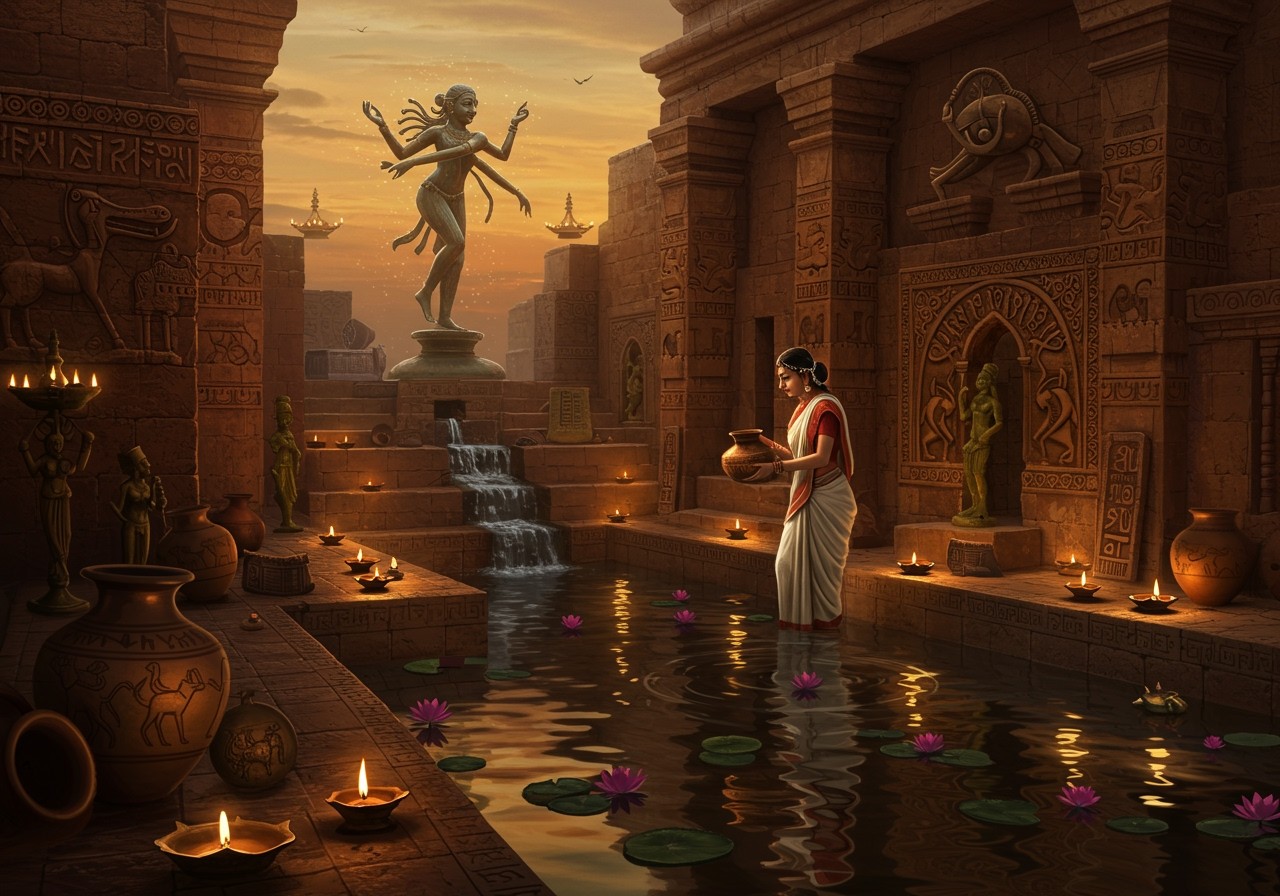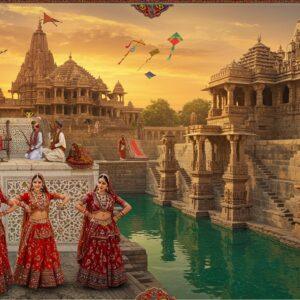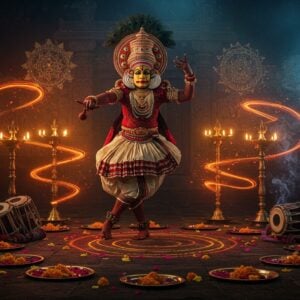
The Indus Valley Civilization, thriving around 2500 BCE in what is now Pakistan and northwest India, stands as a testament to early urban development. Known for its advanced city planning and impressive architecture, it continues to fascinate researchers, especially regarding its spiritual beliefs. This article delves into the potential religious practices of this ancient civilization, examining archaeological evidence and expert interpretations to understand their influence on modern Indian traditions. For those seeking to connect with the spiritual heritage of India, explore the authentic ritual items available at Poojn.in.
The Enigma of the Indus Valley Civilization
Flourishing along the Indus River basin, the civilization encompassed major cities like Mohenjo-Daro and Harappa. This strategic location facilitated growth through agriculture and trade. The cities boasted organized streets, drainage systems, and granaries, showcasing remarkable organizational skills. However, their undeciphered writing system hinders a complete understanding of their culture and beliefs. Despite this challenge, physical evidence offers valuable insights into their way of life, hinting at a rich spiritual landscape. Discover a collection of products inspired by ancient traditions at Poojn.in.
Archaeological Clues to Religious Practices
Artifacts and structures unearthed from the Indus Valley provide glimpses into their religious life. Seals bearing animal figures, such as the ‘Proto-Shiva’ or ‘Pashupati’ seal, suggest early forms of Hinduism. Terracotta figurines, possibly representing deities or fertility symbols, indicate spiritual significance. Fire altars and public baths hint at rituals, perhaps related to purification or worship. These findings suggest that spirituality played a vital role in their daily routines. Explore Lord Shiva murtis at Poojn.in to connect with this ancient spiritual lineage.
Interpreting the Evidence: Scholarly Perspectives
Due to the lack of written records, historians rely on interpretation of symbols and artifacts, leading to various theories. Some propose animism or nature worship, while others suggest early forms of Hinduism. The existence of a uniform religion or diverse local cults is also debated. This ongoing discussion highlights the complexities of understanding ancient belief systems. Poojn.in offers a wide selection of items for various spiritual practices.
Parallels with Other Ancient Religions
Comparing Indus Valley beliefs with contemporary cultures reveals interesting parallels. Early Mesopotamian and Egyptian religions share elements like polytheism and animal symbolism. Links to Vedic religions can be observed in fire worship and specific sacred symbols. These comparisons suggest potential influences on later Hinduism and other Indian religions, providing valuable context for understanding the evolution of ancient spiritual traditions. Enhance your spiritual practice with authentic ritual items from Poojn.in.
The Enduring Legacy: Influence on Modern Indian Traditions
The Indus Valley Civilization’s impact on modern Indian traditions is profound. While its religion remains partially shrouded in mystery, archaeological discoveries provide clues to spiritual beliefs that may have shaped contemporary practices.
Symbols and Beliefs Across Time
- The swastika, a common symbol in the Indus Valley signifying good fortune, continues to hold significance in Hinduism and Jainism. This enduring symbol illustrates the seamless integration of ancient beliefs into modern rituals. Additionally, the reverence for certain animals suggests an intricate connection between spiritual and natural worlds.
- The worship of nature, evident in depictions of animals and plants on seals, reflects a connection to the environment that persists in Indian culture. The veneration of trees, especially the Peepal tree, demonstrates the enduring practice of nature worship. This respect for the natural world continues to inspire ecological awareness and sustainable practices.
Divine Figures and Their Continued Reverence
- Terracotta figurines, possibly representing deities, indicate a focus on fertility and the earth. The prevalence of Mother Goddess figurines suggests a matriarchal aspect within society, influencing the reverence for maternal figures in Hindu mythology. These powerful feminine figures continue to be celebrated in festivals and rituals.
- The male deity depicted on seals, often interpreted as a prototype of Shiva or Pashupati, reveals early connections to Shiva worship. This deity’s association with animals and nature resonates with contemporary depictions of Shiva, highlighting the continuity of this powerful figure in Indian spirituality.
Rituals and Ceremonies: Echoes of the Past
- The Great Bath in Mohenjo-Daro suggests the practice of ritualistic purification. This focus on cleansing parallels with Hindu rituals involving water for spiritual purification, underscoring the enduring importance of cleansing in spiritual practices. This connection can be experienced through products like the Ganga Shiva Murti available at Poojn.in.
- Fire altars discovered at sites like Kalibangan point towards fire worship, a practice central to Vedic rituals and ceremonies. This ancient tradition continues to be observed in various Hindu ceremonies, emphasizing the enduring significance of fire as a sacred element. Mangalam Camphor from Poojn.in can enhance your fire rituals.
Funerary Practices: Honoring the Departed
- The shift from burial to cremation in the Indus Valley mirrors modern Hindu funerary customs. The practice of preserving ashes in urns aligns with contemporary rituals for honoring ancestors. This enduring connection showcases how ancient methods of respecting the deceased have persisted across millennia, reflecting a deep reverence for lineage and the afterlife.
- The careful preservation of ashes in urns demonstrates a deep respect for ancestors and highlights the spiritual significance of honoring the deceased. This practice reflects a belief in the continuity of life beyond death and emphasizes the importance of maintaining connections with past generations.
Ongoing Research and the Quest for Knowledge
Understanding these influences remains challenging due to the undeciphered script and the natural erosion of archaeological sites. However, ongoing excavations continue to reveal more about this ancient civilization. Interdisciplinary research combining archaeology, anthropology, and linguistics enriches our understanding of how these early beliefs have molded modern Indian traditions. Explore the Poojn.in blog for further insights into Indian culture and spirituality.
Poojn.in: Connecting You with Ancient Traditions
Poojn.in provides authentic ritual items that resonate with the ancient spiritual practices of the Indus Valley Civilization. We support your connection to this rich heritage by offering:
Sacred Items for Worship:
- Pure copper and brass items, reminiscent of those used in Indus Valley rituals, connect you with the ancient practices. These materials are believed to hold spiritual significance and enhance the efficacy of rituals. Brass Laddu Gopal Murti is a beautiful example available at Poojn.in.
- Traditional clay lamps (diyas) allow you to maintain the ancient customs of fire worship. These lamps symbolize the dispelling of darkness and the invocation of positive energy. Kushal Mangal Sandalwood Agarbatti can complement your lamp rituals.
- Natural incense and dhoop, crafted from authentic ingredients, create a sacred atmosphere for your spiritual practices. These aromatic offerings purify the air and invoke a sense of reverence.
Ritual Essentials:
- Genuine rudraksha malas aid in meditation practices, promoting focus and tranquility. These beads are believed to possess powerful spiritual properties.
- Pure cotton wicks for ceremonial lamps ensure the purity of your fire rituals. Natural materials are essential for maintaining the authenticity of traditional practices.
- Sacred threads and other religious accessories complete your ritualistic needs, enhancing your connection with the divine.
More Products at Poojn.in:
Explore our extensive collection of authentic ritual items, including copper kalash, brass aarti thali sets, traditional clay agarbatti stands, pure cotton wicks, natural camphor tablets, and rudraksha malas in various sizes. Visit Poojn.in today.
A Timeless Connection: Preserving a Rich Heritage
The spiritual beliefs of the Indus Valley Civilization form a timeless link between ancient practices and modern Indian traditions. Symbols, reverence for nature, and echoes of ancient deities resonate through time. While mysteries remain, the influence of the Indus Valley continues to enrich Indian culture, celebrating a rich heritage and deep respect for traditions.
FAQs on Indus Valley Civilization Beliefs
What was the religion of the Indus Valley Civilization? The religion of the Indus Valley Civilization is a complex subject with no definitive answer. Archaeological evidence, including seals, figurines, and symbols, points towards nature worship, a possible Mother Goddess figure, animal reverence, and potential early forms of Hinduism. The lack of deciphered written records leaves much open to interpretation.
What type of religion did the Indus Valley Civilization have? The Indus Valley Civilization likely practiced polytheism, believing in multiple gods and goddesses. Rituals and sacred symbols probably played a significant role in their religious life. However, without written texts, the exact nature of their beliefs remains speculative.
Why can historians only speculate on the religion of the Indus Valley Civilization? Historians primarily speculate due to the absence of deciphered written texts explaining their beliefs. While artifacts and symbols offer clues, they don’t provide a complete picture, leading to scholarly interpretations and ongoing debates.
Did the Indus Valley Civilization have temples or religious structures? No clear evidence of large, elaborate temples exists. However, structures like the Great Bath in Mohenjo-Daro suggest potential ritualistic use, possibly for purification ceremonies. Fire altars also indicate the practice of fire worship.
Were animals important in Indus Valley religious beliefs? Yes, animals appear to have held religious significance. Many seals depict animals such as bulls and elephants, suggesting their importance in the spiritual world. The “Pashupati” seal, showing a figure surrounded by animals, further emphasizes this connection.
Is there any connection between Indus Valley beliefs and Hinduism? Some scholars propose links between Indus Valley beliefs and Hinduism due to shared symbols and practices. The potential Mother Goddess figure, animal reverence, and certain rituals appear to have parallels in later Hindu traditions.
Did the Indus Valley people worship a Mother Goddess? The prevalence of female figurines suggests the possibility of a Mother Goddess figure representing fertility and nature. This concept is common in many ancient religions and might have influenced later Hindu goddesses.
How do artifacts help in understanding Indus Valley religion? Artifacts like seals, pottery, and sculptures provide valuable clues about their beliefs. The images and symbols depicted on these artifacts offer insights into what might have been important in their spiritual life.


